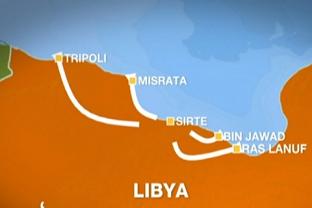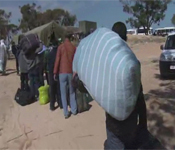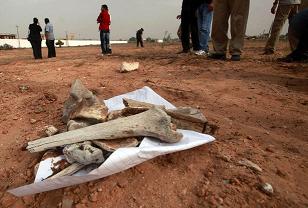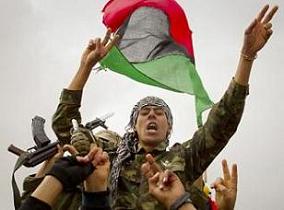Fighters of Libya’s National Transitional Council, backed by NATO warplanes, encircled on Monday the ousted leader’s hometown of Sirte.
 Fighters of Libya’s National Transitional Council, backed by NATO warplanes, encircled on Monday the ousted leader's hometown of Sirte on the Mediterranean coast from the east, south and west.
Fighters of Libya’s National Transitional Council, backed by NATO warplanes, encircled on Monday the ousted leader's hometown of Sirte on the Mediterranean coast from the east, south and west.
NATO said on Monday that its aircraft had hit a command and control node, three ammunition or vehicle storage facilities, a radar facility, a multiple rocket launcher, a military support vehicle and an artillery piece in Sirte.
The previous day, the alliance blew up 29 armed vehicles, a firing position, two command and control nodes and three ammunition storage facilities in the city.
CIVILIANS FLEEING
Meanwhile, some of 70,000 civilians have fled the oasis. The y spoke of rapidly deteriorating conditions for the remaining residents.
 "NATO has been bombing continuously. The children are scared. We had to leave. There was no option", said a Sirte resident who asked not to be identified was leaving the city with around 20 relatives.
"NATO has been bombing continuously. The children are scared. We had to leave. There was no option", said a Sirte resident who asked not to be identified was leaving the city with around 20 relatives.
Another resident, said Muftah Mohammed, who was also leaving in a convoy of seven vehicles with around 60 relatives and neighbors, said: The situation in the city is very critical".
"There is no food, no water, no petrol and no electricity. This has been going on for nearly two months now as Kadhafi forces would not allow us to leave".
Mohammed said that African mercenaries deployed in the city centre and on rooftops had been preventing residents from leaving.
"They are from Chad. They used to threaten us if we tried to leave", he said.
"Children are in a particularly bad condition. There is no milk for them. We have all been surviving on just macaroni for several days."
MASS GRAVE UNEARTHED On the other hand, the siege of one of Gaddafi’s last bastions came as Libya's new rulers said they had unearthed a mass grave in Tripoli of 1,700 prisoners slain by his regime in a 1996 uprising, a massacre that helped trigger the revolt that ousted the despot.
On the other hand, the siege of one of Gaddafi’s last bastions came as Libya's new rulers said they had unearthed a mass grave in Tripoli of 1,700 prisoners slain by his regime in a 1996 uprising, a massacre that helped trigger the revolt that ousted the despot.
A spokesman for the NTC's military council, Khalid Sharif, said the The gruesome find in a mass grave of the remains of prisoners executed at Tripoli's notorious Abu Salim jail was yet further proof of "criminal acts"
"We found the place where all these martyrs were buried," Sharif announced on Sunday in Tripoli.
Salim al-Farjani, a member of the committee set up to identify the remains, appealed for international help.
"We call on foreign organizations and the international community to help us in this task of identifying the remains of more than 1,700 people," said Farjani.
The first demonstrations in Libya which finally ousted Kadhafi last month erupted in Benghazi in February, when families of Abu Salim victims called for protests against the arrest of their lawyer.
Farjani said he witnessed the gruesome site where the Abu Salim victims were found.
"We were invited to visit the place where the corpses of the prisoners at Abu Salim were found, where we saw scattered human bones," he said.
Farjani also referred to "egregious acts committed against dead bodies, on which acid was poured to eliminate any evidence of this massacre."
